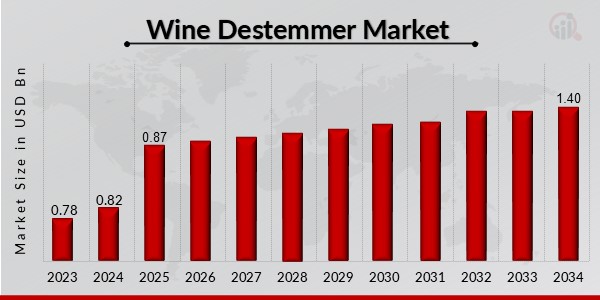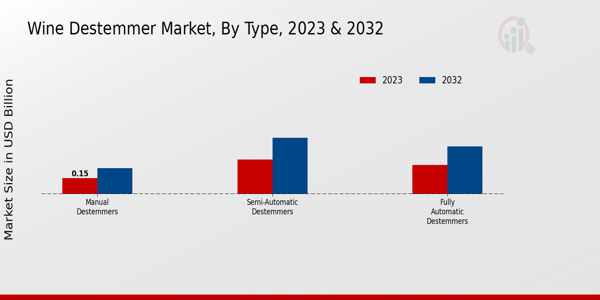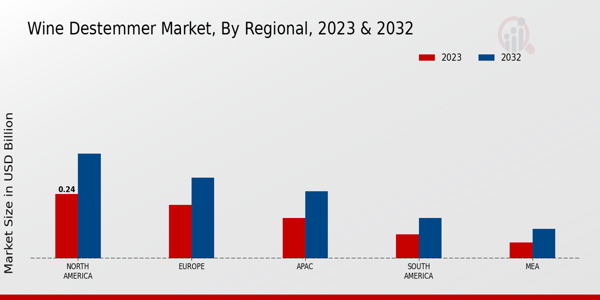Global Wine Destemmer Market Overview
Wine Destemmer Market Size was estimated at 0.82 (USD Billion) in 2024. The Wine Destemmer Industry is expected to grow from 0.87 (USD Billion) in 2025 to 1.40 (USD Billion) by 2034. The Wine Destemmer Market CAGR (growth rate) is expected to be around 5.5% during the forecast period (2025 - 2034).

Source: Primary Research, Secondary Research, MRFR Database and Analyst Review
Key Wine Destemmer Market Trends Highlighted
The Wine Destemmer Market has several drivers that act as key market influencers. First among them would be the increasing quality wine consumption due to the fact that consumers tend to patronize high-end and artisanal sectors. This trend drives wineries to upgrade their processing facilities and invest in modern destemmers, among others. Other factors that are also enabling this market expansion include the rising demand for wine from the developing markets owing to producers looking for effective and efficient means of grape processing. There are also environmental issues, which are more present now than ever, focusing on encouraging sustainable means of winemaking, which can help in increasing the adoption rate of advanced destemming systems.
There are numerous opportunities to explore in the Wine Destemmer Market for manufacturers and suppliers. The growing trend of personalized wine experiences has prompted smaller wineries to seek solutions that allow for more tailored production methods. This presents a chance for companies to develop specialized destemming machines that cater to these smaller producers, offering them solutions that are flexible and efficient. Furthermore, the integration of smart technologies in winemaking processes opens doors for advanced destemmers that can monitor and adjust operations in real-time, ensuring optimal grape handling. As sustainability continues to be at the forefront of consumer preferences, there is potential for creating eco-friendly destemming solutions that align with environmentally conscious practices.In these past few years, the trends such as automation and digitalization have been explored deeply in the field of wine making. The wine industry has been looking up to technology to assist in refining its production methods. This is evidenced by the improved acceptance of smart destemmers that enable a more sophisticated way of managing and optimizing the processing of grapes. There is also a developing sense that due to the current growth in focus of consumers towards organic and natural wines there is a requirement for feasible designs of the destemmer that would preserve the integrity of the grapes as much as possible. These recent developments reflect the emerging trends of innovation and sustainability in the market, creating an opportunity for future growth that will be able to respond to the evolution in the requirements of wine producers.
Wine Destemmer Market Drivers
Increasing Demand for High-Quality Wine Production
The Wine Destemmer Market Industry is witnessing a significant rise in the demand for high-quality wine, which is a crucial driver for market growth. As consumers become more discerning about the wines they choose, winemakers are focusing on enhancing the quality of their products. This shift towards premium wines has resulted in a heightened need for innovative equipment that can help maintain the integrity of grapes during the winemaking process.The destemming process is critical, as it ensures that the stems are removed, which can negatively affect the flavor profile of the wine if not handled properly. The transition toward modern winemaking techniques involves the adoption of advanced destemming machinery, which aligns with the industry's goal of producing superior wines that meet consumer expectations. Additionally, the growth of wine tourism and a burgeoning interest in artisanal and locally produced wines are driving wineries to invest more in their production equipment.These wineries are increasingly understanding that having modern destemming equipment not only improves efficiency but also enhances the overall quality of the wine. Hence, the evolving market dynamics favor the expansion of the Wine Destemmer Market as more vintners make the necessary capital investments in quality production processes.
Technological Advancements in Winemaking Equipment
The Wine Destemmer Market Industry is significantly influenced by ongoing technological advancements in winemaking equipment. Innovations such as automated destemmers and enhanced sorting systems have revolutionized the winemaking process, allowing for greater efficiency and precision. These modern machines are capable of processing large volumes of grapes quickly, ensuring that the delicate fruit is handled with care to prevent damage. Furthermore, the integration of smart technology, including IoT capabilities, enables real-time monitoring and adjustment of destemming processes, further optimizing production.The continuous improvement of wine processing equipment is crucial as wineries seek to enhance their operational efficiency, thereby contributing to the growth of the market.
Expansion of the Wine Industry in Emerging Markets
The Wine Destemmer Market Industry is being positively impacted by the expansion of the wine industry in emerging markets. Countries such as China, India, and Brazil are witnessing an increase in wine consumption, leading to a surge in the establishment of new wineries. This growth presents a significant opportunity for manufacturers of wine destemming equipment to cater to the needs of these new entrants in the market. Moreover, as these emerging markets develop a taste for wine, there is a higher inclination towards producing quality products, which requires modern destemming technology.This trend is expected to bolster the demand for wine destemmers and subsequently drive the overall growth of the market.
Wine Destemmer Market Segment Insights
Wine Destemmer Market Type Insights
The Wine Destemmer Market revenue is experiencing notable growth, poised to reach a valuation of 0.74 USD Billion in 2023. This market can be dissected into various types, which play a critical role in its segmentation. Among these, Manual Destemmers are valued at 0.15 USD Billion and are projected to grow to 0.24 USD Billion by 2032. Despite being the smallest segment, Manual Destemmers hold significance for small-scale wineries due to their cost-effectiveness and ease of use. In contrast, Semi-Automatic Destemmers represent a more substantial fraction of the market, with a valuation of 0.32 USD Billion in 2023, forecasted to rise to 0.52 USD Billion by 2032, highlighting their popularity among medium-sized wineries that balance efficiency and affordability.This segment caters to wineries aiming for a versatile option that can enhance productivity without extensive investment in fully automated systems. The Fully Automatic Destemmers segment, holding a value of 0.27 USD Billion in 2023 and expected to expand to 0.44 USD Billion by 2032, dominates the market growth due to technological advancements that promise precision and high output for larger operations. Such automatic systems are increasingly favored by commercial wineries that require high throughput, thus accommodating the demand for consistent production efficiency, which is pivotal in the competitive landscape of wine manufacturing.Overall, the Wine Destemmer Market statistics depict a landscape where Semi-Automatic and Fully Automatic Destemmers lead in revenue generation, showcasing a shift toward more sophisticated technologies as the industry evolves. The trends in consumer preferences, marked by a demand for efficiency and quality, are driving the growth of these segments as wineries adapt to emerging market dynamics. The analysis of Wine Destemmer Market data reveals that while all segments have their unique contributions, the Fully Automatic Destemmers are on track for significant advancements, given the industry's trajectory toward higher automation.However, challenges such as the initial investment cost and technological adaptation might impact the growth pace across different types of markets. Nevertheless, opportunities persist in driving innovation and optimizing processes, propelling the Wine Destemmer Market industry forward as producers seek to enhance quality while managing costs efficiently.

Source: Primary Research, Secondary Research, MRFR Database and Analyst Review
Wine Destemmer Market Material Insights
The Wine Destemmer Market, particularly within the Material segment, showcases a substantial growth trajectory as the market continues to evolve. In 2023, the market was valued at 0.74 USD Billion, demonstrating robust demand for quality wine production equipment. As the industry progresses towards 2032 with a projected value of 1.2 USD Billion, various materials utilized in manufacturing wine destemmers play a critical role. Stainless steel emerges as a preferred choice due to its durability and resistance to corrosion, making it instrumental for high-volume wineries.Aluminum, recognized for being lightweight yet strong, provides effective solutions for smaller operations looking to optimize efficiency without compromising quality. Plastic materials, while less prevalent, appeal to niche markets, focusing on cost-effective solutions suitable for smaller batches. The diverse range of materials also fuels market growth by meeting various operational requirements, thereby enhancing production capacity. The Wine Destemmer Market statistics reflect a rapidly developing landscape, presenting both opportunities and challenges as the industry strives for innovation and sustainability, ultimately driving the overall market growth.
Wine Destemmer Market Capacity Insights
The Wine Destemmer Market’s capacity segment encompasses various scales of operation, primarily categorized as small scale, medium scale, and large scale. In 2023, the market was valued at 0.74 billion USD, reflecting a steady growth trajectory that aligns with global wine production trends. The demand for wine destemmers is significantly driven by the increasing need for efficiency and quality in wine production. Small scale operations often cater to boutique wineries, emphasizing artisanal production and unique flavors, making them vital in niche markets.Medium scale operations strike a balance between production efficiency and quality, appealing to a broader market segment. Meanwhile, large scale operations dominate the production landscape due to their ability to meet high-volume demands, leveraging advanced technology and economies of scale. This segmentation illustrates the diverse needs across the industry, allowing for tailored solutions to enhance the overall efficiency of the winemaking process. Overall, understanding the dynamics within these segments provides valuable insights into the Wine Destemmer Market revenue and its prospective growth avenues, highlighting the importance of each capacity category in contributing to market statistics and dynamics.
Wine Destemmer Market End Use Insights
The Wine Destemmer Market is expected to be valued at 0.74 USD Billion in 2023, showcasing its growing significance within the beverage industry. As the market evolves, the End Use segment is categorized into areas such as Winery, Brewery, and Commercial Production. Each of these fields plays a vital role; for instance, wineries typically dominate the market due to their essential requirement for efficient grape processing methods, reflecting a significant share of the Wine Destemmer Market revenue. Breweries are also becoming more important as craft beer production grows, leading to increased demand for specialized equipment.Additionally, the rise in commercial production, fueled by larger-scale operations and the quest for consistency, further contributes to the market’s expansion. Trends such as the increased focus on sustainable practices and technological advancements are expected to drive the Wine Destemmer Market growth, while challenges such as fluctuating grape supply and changing consumer preferences may impact revenue generation. Overall, the market statistics highlight a dynamic industry positioned for substantial growth through 2032, offering various opportunities within these key segments.
Wine Destemmer Market Regional Insights
The Regional analysis of the Wine Destemmer Market reveals significant trends and insights across various areas. In 2023, North America leads with a market valuation of 0.24 USD Billion and is expected to expand to 0.39 USD Billion by 2032, showcasing its dominant position, likely due to its established wine industry and increasing consumer demand. Europe follows closely, valued at 0.20 USD Billion in 2023 and projected to reach 0.30 USD Billion, reflecting its rich heritage in winemaking, which drives substantial market activity. The APAC region, valued at 0.15 USD Billion in 2023 and anticipated to grow to 0.25 USD Billion, shows potential for expansion as wine consumption increases among emerging economies.South America, with a valuation of 0.09 USD Billion in 2023 and a growth to 0.15 USD Billion, benefits from its favorable climatic conditions for grape cultivation, supporting wine production. Lastly, the MEA segment, valued at 0.06 USD Billion in 2023 and expected to rise to 0.11 USD Billion, plays a lesser role but highlights potential opportunities for growth within niche markets. The overall market showcases a steady trajectory influenced by growing wine consumption, advancements in winemaking technology, and increasing consumer preferences for high-quality wine products.

Source: Primary Research, Secondary Research, MRFR Database and Analyst Review
Wine Destemmer Market Key Players and Competitive Insights
The Wine Destemmer Market has seen significant growth, fueled by increasing consumer demand for wine and corresponding advancements in winemaking technologies. This sector is characterized by a diverse range of players, including manufacturers, suppliers, and distributors, each contributing to the competitive landscape. Enhanced efficiency, quality of production, and innovations in destemming processes have become focal points through which companies strive to differentiate themselves. This market is also influenced by regional trends, changes in wine consumption patterns, and the growing trend of organic and natural wines, which in turn intensify the competitive dynamics among the key players operating within this space.Sauternes has established a strong presence in the Wine Destemmer Market, capitalizing on its reputation for high-quality equipment that significantly enhances the winemaking process. One of its primary strengths lies in its innovative design that optimally separates grapes from stems, thereby ensuring the purity and integrity of the wine. The company's commitment to quality is reflected in the durable materials and advanced technology used in manufacturing its destemmers, allowing for efficient processing and less waste. Additionally, Sauternes’ ability to customize solutions according to specific winemaking needs has bolstered its market position, fostering trust among wineries that seek reliability and performance. This focus on client-centric solutions and operational efficiency has facilitated Sauternes’ sustained competitive advantage.Zinfandel, on the other hand, has carved out a unique niche within the Wine Destemmer Market, distinguished by its emphasis on user-friendly machines designed for both small-scale wineries and larger commercial operations. The company's strengths include a well-established reputation for producing high-performance destemmers that combine simplicity of use with exceptional output quality. The robust design of Zinfandel's equipment ensures minimal downtime and maximum throughput, making it an attractive choice for producers looking to streamline their processes. Furthermore, Zinfandel has continuously invested in research and development, resulting in innovative features such as automated settings and smart technology integration, catering to the evolving demands of modern winemaking. This innovation-driven approach has enabled Zinfandel to maintain relevance and competitiveness in a rapidly changing market landscape.
Key Companies in the Wine Destemmer Market Include
- Sauternes
- Zinfandel
- Simeone
- Hawke
- Porsche
- Simi
- Cabernet
- Prosecco
- Della Valle
- Tigani
Wine Destemmer Market Industry Developments
The Wine Destemmer Market has seen several significant developments recently, particularly in response to growing consumer demand for high-quality wines. Companies like Sauternes, Zinfandel, and Simi are emphasizing technological advancements in destemming processes to enhance the quality of wine production. Notable trends indicate an increasing focus on sustainability and efficiency in winemaking. Current affairs suggest a rise in capital investments among major players like Prosecco and Della Valle, which aim to modernize equipment and bolster production capabilities. Additionally, companies are exploring acquisitions to expand their market reach; however, as of now, specific mergers involving Hawke, Porsche, or Tigani have not been publicly disclosed. In terms of market valuation, organizations such as Cabernet are experiencing growth, attributed to a surge in interest in premium wines, which is positively influencing the overall market dynamics. Enhanced winemaking methods are expected to uplift the market valuation significantly, solidifying these companies' positions as leaders in the sector. Thus, the interplay of innovation, investment, and market demand is shaping the future trajectory of the Wine Destemmer Market.
- Wine Destemmer Market Segmentation Insights
- Wine Destemmer Market Type Outlook
- Manual Destemmers
- Semi-Automatic Destemmers
- Fully Automatic Destemmers
- Wine Destemmer Market Material Outlook
- Stainless Steel
- Aluminum
- Plastic
- Wine Destemmer Market Capacity Outlook
- Small Scale
- Medium Scale
- Large Scale
- Wine Destemmer Market End Use Outlook
- Winery
- Brewery
- Commercial Production
| Report Attribute/Metric |
Details |
| Market Size 2024 |
0.82 (USD Billion) |
| Market Size 2025 |
0.87 (USD Billion) |
| Market Size 2034 |
1.40 (USD Billion) |
| Compound Annual Growth Rate (CAGR) |
5.5% (2025 - 2034) |
| Report Coverage |
Revenue Forecast, Competitive Landscape, Growth Factors, and Trends |
| Base Year |
2024 |
| Market Forecast Period |
2025 - 2034 |
| Historical Data |
2019 - 2024 |
| Market Forecast Units |
USD Billion |
| Key Companies Profiled |
Sauternes, Zinfandel, Simeone, Hawke, Porsche, Simi, Cabernet, Prosecco, Della Valle, Tigani |
| Segments Covered |
Type, Material, Capacity, End Use, Regional |
| Key Market Opportunities |
Technological advancements in destemming, Rising demand for sustainable equipment, Expansion in emerging wine regions, Increasing adoption of automation, Growth in organic wine production |
| Key Market Dynamics |
increased wine production, technological advancements, sustainability trends, rising consumer preferences, expanding global distribution channels |
| Countries Covered |
North America, Europe, APAC, South America, MEA |
Frequently Asked Questions (FAQ) :
The Wine Destemmer Market is expected to be valued at 1.40 billion USD by 2034.
The expected CAGR for the Wine Destemmer Market from 2025 to 2034 is 5.5%.
North America is expected to have the largest market share, valued at 0.39 billion USD by 2034.
The Manual Destemmers segment is valued at 0.15 billion USD in 2024 and is expected to reach 0.24 billion USD by 2034.
Major players in the Wine Destemmer Market include Sauternes, Zinfandel, Simeone, and Prosecco.
The Semi-Automatic Destemmers segment is expected to be valued at 0.52 billion USD by 2034.
The APAC region is anticipated to experience notable growth, with a market size of 0.25 billion USD by 2034.
The Fully Automatic Destemmers segment is valued at 0.27 billion USD in 2024.
Key growth drivers include increasing wine production and advancements in destemming technology.
The South America segment is expected to reach a total market value of 0.15 billion USD by 2034.

















